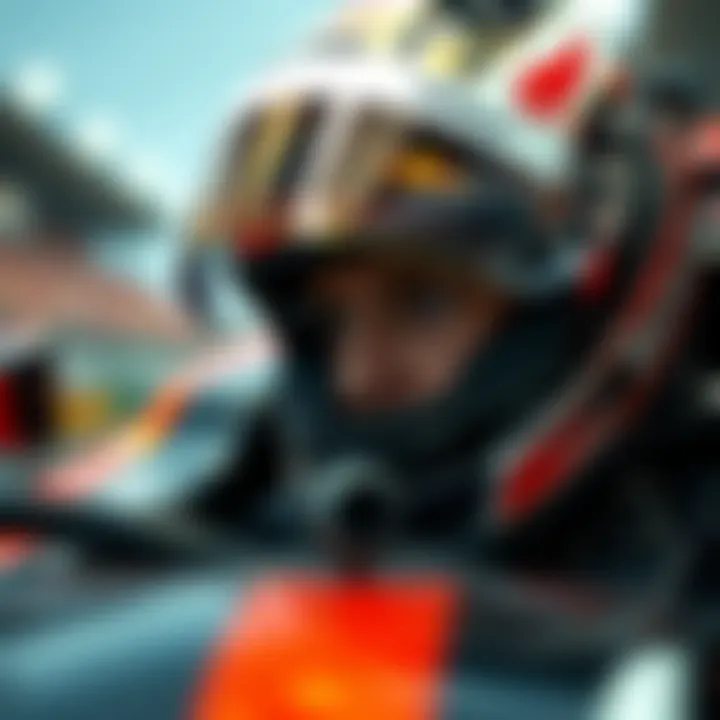The Complexities of Driving a Formula One Car


Intro
Driving a Formula One car is a tantalizing blend of technical prowess, psychological endurance, and physical stamina. Picture yourself seated in a machine that screams down a track at speeds that make your heart race faster than a century’s worth of caffeine shots. Understandably, it’s not just about turning a wheel; it’s about mastering a symphony of mechanical interfaces, strategies, and the pressures of competition.
Motor racing pushes the limits, and Formula One stands as a pinnacle of this extreme sport world, attracting thrill-seekers and enthusiasts alike. The intricate dynamics of these highly engineered machines, coupled with the mental resilience required to pilot them, elevate the experience beyond that of ordinary driving.
Every minute spent in the cockpit reveals layers of complexity. From quick shifts in balance to the heat of tires on asphalt, each aspect must be finely tuned and skillfully managed. This makes understanding these subtleties essential for those who aspire to take the wheel. So, let’s dive into the depths of what it means to drive a Formula One car and grasp the skills that can separate a good driver from a great one.
Understanding Formula One Racing
In the world of motorsport, the significance of understanding Formula One racing can’t be overstated. This thrilling domain is not just about speed; it intertwines engineering marvels with human skill, and dives deep into both psychological and physical prowess. Grasping the many facets of this sport enriches the experience for fans and aspiring drivers alike.
One might argue that Formula One stands apart from all other racing formats due to its intricate details and multilayered strategies. When one understands the foundational components of F1, like the engineering behind the vehicle or the precision required in driving, it lays the groundwork for appreciating every detail on the track. This doesn’t just illuminate what happens during a race but also shines light on the preparation that precedes the roar of engines.
The Evolution of Formula One
Formula One has undergone a seismic shift since its inception in the mid-20th century. Beginning as a simple test of speed, it has blossomed into a highly sophisticated sport that merges technology with athleticism.
Over the decades, the introduction of turbocharged engines, advanced telemetry systems, and aerodynamic innovations paved paths that old-school racers could only dream of. Each era brought distinct changes, whether it was the two-seater cars of the early days or the all-electric motor units we see today. The transition from mechanical to hybrid engines signifies not just progress in speed but also an evolution in the sustainability of racing. Now, teams strive for energy efficiency alongside speed, addressing environmental concerns while still giving fans what they crave: high-octane racing.
Key Engineering Principles
A dive into Formula One without recognizing the core engineering principles is akin to driving a car without knowing the steering wheel's purpose. Here we examine the three pillars: chassis design, aerodynamics, and power units.
Chassis Design
Chassis design forms the backbone of a Formula One car, crucially supporting all other elements, including the engine and suspension. The choice of materials, generally carbon fiber for its combination of strength and lightness, is pivotal. This contributes to the overall goal of minimizing weight while maximizing durability and safety.
A notable feature of modern chassis design is the monocoque structure, which acts almost like a protective shell around the driver, ensuring safety in case of a crash. This innovation makes F1 cars not only faster but significantly safer than their predecessors. Despite the benefits, high development costs can turn chassis design into a double-edged sword; teams often face substantial financial pressure to innovate continuously.
Aerodynamics
Aerodynamics is another cornerstone. In the realm of F1, it’s not just about looking sleek; it’s about sculpting the car to cut through air efficiently. Designers work tirelessly on profiles and wing shapes that maximize downforce while minimizing drag. This unique balancing act is vital for maintaining grip and speed during turns.
One interesting aspect is the adjustable wing technologies that allow drivers to modify aerodynamics during a race. This innovation can lead to strategic advantages, enabling them to optimize performance based on track conditions. However, miscalculations can lead to detrimental effects; too much downforce can slow a car down in a straight line, showcasing the complexity of the task.
Power Units
Power units have switched from purely combustion engines to complex hybrids that combine traditional fuel with electric components. The modern F1 car's power unit delivers not only power but also efficiency and responsiveness. This change signifies a leap towards ecological considerations within the sport, adapting to global trends of energy consumption.
The energy recovery systems (ERS) allow drivers to harness kinetic energy for increased acceleration, making it a valuable tool during critical moments in a race. However, the intricacies of managing these systems require a driver’s sharp focus and skill to maximize their effectiveness.
In summary, understanding Formula One racing involves a tapestry of elements including engineering principles, historical context, and strategic sharpness. These intricacies transform mere spectators into avid enthusiasts who appreciate the depth behind each race. The allure of Formula One lies not just in its speed but also in its evolution and the precision required to conquer it.
The Anatomy of a Formula One Car
Understanding the anatomy of a Formula One car is essential for grasping the intricacies of driving one. Each component plays a significant role in the vehicle's performance and handling characteristics, which ultimately influences the driver's experience on the track. In this section, we will analyze the core components, how they interact, and why they are indispensable for achieving speed and precision in Formula One racing.
Components Overview
Suspension Systems
One of the crucial aspects of a Formula One car is its suspension system. The suspension is not merely about providing comfort; it directly influences how the car handles and behaves under different conditions. A key characteristic of suspension systems in Formula One is the use of double-wishbone configurations. This design allows for better tire contact with the track, which optimizes grip and enhances cornering capabilities.
The unique feature of this system is its adjustability. Engineers can fine-tune the suspension settings based on track characteristics and driver preferences, providing a tailored driving experience. While this adaptability is a significant advantage, it does require highly skilled technicians to set up correctly, as even slight adjustments can dramatically affect how the car performs.
Tyres and Their Role
Tyres are often dubbed the "only contact" between the car and the track, playing a pivotal role in a driver's ability to maintain speed, especially during tight corners. Different compounds are available, each designed for specific track conditions. A notable characteristic is the availability of soft, medium, and hard compounds, which offer varying levels of grip and durability.


The unique feature of F1 tyres is their construction, designed to heat up quickly, ensuring maximum performance in short spans of time. However, this can be a double-edged sword. While softer compounds provide incredible grip, they can wear out rapidly, potentially resulting in a strategic dilemma for teams during a race when they must balance speed against durability.
Braking Mechanisms
In Formula One, braking mechanisms are integral to performance and safety. The highly advanced carbon-carbon brakes allow for rapid deceleration and heat dissipation, significantly enhancing the ability to slow down from high speeds. A key characteristic of these brakes is their effectiveness at extreme temperatures, making them a favorite in high-performance racing environments.
The unique advantage is that they require minimal pedal pressure to achieve maximum stopping power, allowing drivers to push the limits even further. However, a downside is their sensitivity; if not managed well, they can easily overheat, leading to brake fade or complete failure if the driver does not adjust their approach accordingly.
The Importance of Weight Distribution
Weight distribution is another critical aspect of a Formula One car, affecting its handling and overall performance. Achieving the ideal balance between the front and rear weight is crucial for optimizing handling. A well-distributed car provides better grip and allows for more controlled cornering.
It's vital for drivers and engineers to work together to find the perfect setup that complements the driver's style and the specific demands of each circuit. An improper weight distribution can lead to understeering or oversteering, both of which can jeopardize race performance.
Exploring these components makes clear that the anatomy of a Formula One car is not just a collection of high-tech parts; it is a complex ecosystem where engineering meets the art of driving. Each piece interacts dynamically, culminating in the thrilling spectacle of Formula One racing.
Driving Skills Required
Driving a Formula One car demands more than just an average set of skills. It’s a blend of precision, timing, and adaptability that makes a driver truly exceptional. These competencies don’t just enhance the driving experience; they are essential for manipulating a machine that can reach astonishing speeds while maintaining full control.
Precision and Control
In Formula One, every millisecond counts. When drivers navigate the twists and turns of a track, they need an extraordinary level of precision and control. The steering response of an F1 car can be razor-sharp, meaning that any slight over or under-correction can lead to dire consequences. It’s not just about pushing the pedal to the metal; it’s a delicate dance between throttle control and steering inputs. Drivers must also understand the feedback from the car, which provides intuitive signals about grip and balance. This harmony between driver and car can mean the difference between victory and defeat.
Understanding Racing Lines
An effective racing line is the route that maximizes speed and minimizes distance around a track. This requires drivers to analyze every turn's apex, entry, and exit points. They must master the art of approaching corners not just with speed but also with an accurate calculation of their car’s handling dynamics.
The racing line changes depending on a variety of factors like track surface, weather, and tire conditions. As such, understanding racing lines isn't just a skill—it's an ongoing interaction with the circuit, compounded by past experiences and situational awareness. A driver who can quickly adapt and find the optimal line in a race can extract tremendous performance from their car.
Adapting to Track Conditions
In the highly volatile environment of Formula One, drivers must remain flexible. Adapting to track conditions is an ongoing requirement that can make or break a race.
Dry vs Wet Conditions
Wet conditions add a layer of complexity that demands heightened skills. On a dry track, a driver enjoys predictable grip levels, allowing precise control. However, when it rains, the surface gets slippery, and aquaplaning becomes a concern. The nuances of wet driving include understanding where traction can be found and how to adjust braking points accordingly. This is a skill that separates the good from the great.
In dry conditions, the tires perform optimally, conveying a well-balanced response which makes high-speed cornering manageable. On the other hand, wet conditions require a more cautious approach to avoid losing control. Despite its challenges, mastery of wet conditions is often viewed as a hallmark of an elite driver.
Grip Levels
Grip levels fluctuate depending on the tire composition, weather, and track surface. A driver must be acutely aware of these changes. Low grip situations demand a different driving style, slightly gentler inputs and an innate ability to feel when the tires begin to lose traction.
High grip conditions, while easier, can lead to overconfidence. Misjudging the available grip leads to mistakes and missed opportunities in overtakes or lap time improvements. Continuous adaptation to varying grip levels contributes significantly to a driver's success on race day. By being cognizant of how to maximize adhesion, they can exploit every corner and straightaway to its fullest.
"The difference between success and failure in Formula One often hinges on how well a driver can adapt to the ever-changing conditions."
Physical and Mental Preparation
The journey to becoming a top-tier Formula One driver is not merely a matter of acquiring fancy skills behind the wheel. It is an intricate ballet of physical strength and mental agility. Drivers endure extreme conditions during races, both physically and mentally. Their bodies must withstand high g-forces and maintain control while navigating complex circuits. Thus, preparing both physically and mentally is fundamental to their success on the track.
Fitness Regimens for Drivers
Fitness serves as the backbone of a driver’s performance, ensuring they can sustain focus and endure long races. It matters not just for driving prowess but also for safety and endurance.
Strength Training
Strength training forms a key aspect of every driver’s fitness regime, focusing on building muscle groups that play a critical role in controlling the car. Effective core muscles provide stability and strength during high-speed maneuvers.
The main characteristic of strength training for drivers is its focus on functional strength – the ability to control the car effectively during intense physical demands. This aspect highlights a common misconception that strength means bulking up. Instead, it's about refining power-to-weight ratio without losing agility.


This type of training usually includes weightlifting, resistance exercises, and even resistance bands tailored to enhance grip. Drivers must possess a unique combination of strength and finesse, focusing on balance and core stability, which contributes positively to their overall performance on the track. On the downside, intense strength training could lead to fatigue or overheating if not managed well, which can hinder performance.
Cardiovascular Fitness
Cardiovascular fitness is another essential component for drivers, allowing them to maintain optimal performance during grueling races. High heart rates, dehydration, and the g-forces experienced can take a toll, so enduring capabilities must be fine-tuned.
One of the key characteristics of cardiovascular fitness in this context is endurance; it’s all about training the body to withstand prolonged periods of high stress. This becomes a hot topic for aspiring drivers who are serious about making it to the top.
Training routines often involve cycling, running, or swimming – activities that increase lung capacity and enhance blood flow. However, the unique feature of cardiovascular training for F1 drivers lies in high-intensity interval training (HIIT), which prepares them to handle sudden bursts of energy demands during overtakes or when maximizing speed. Although the upside is greater resilience and better recovery rates, the risk of injury and overtraining persists, emphasizing a balanced approach.
Mental Toughness and Focus
The mental aspect of Formula One driving is just as dynamic as the physical. Drivers need to harness mental toughness, ensuring they can cope with the intense pressure of competition. Racing demands meticulous focus, the ability to process vast amounts of information rapidly, and making instantaneous decisions that could determine victory or defeat unexpectedly.
Mental preparation methods vary; some drivers employ visualization techniques, mentally rehearsing their routes and strategies. Visualization has proven effective as it enhances confidence and prepares drivers for the unexpected on race day. Others engage in mindfulness practices, which optimize concentration and combat distractions throughout HP. A well-rounded mental strategy, paired with diligent physical training, creates the strongest candidate for thriving on the global stage of motorsport.
Understanding the balance of mind and body is essential. Good drivers know it’s not just about speed; it’s about resilience and adaptability.
The Role of Technology
In the high-speed world of Formula One, technology acts as an invisible hand that guides every facet of racing. It shapes not only the design and practical operational aspects of the car but also influences drivers’ strategies and overall performance on the track. Modern technology in Formula One is akin to a double-edged sword; it enhances capabilities while demanding a high level of understanding and integration from both engineers and drivers. The advantages that come with advanced technological innovations are indeed transformative, yet they also require a continuous adaptation to the ever-evolving landscape of this motorsport.
From telemetry systems that capture a myriad of data points in real time to sophisticated simulation tools that aid in driver preparations, technology permeates every aspect of the sport. It creates a synergy between human skill and machine precision, contributing to what makes Formula One not only a thrilling spectacle but also a complex, multi-dimensional competition.
Telemetry and Data Analysis
Telemetry serves as the lifeblood of modern Formula One racing, transmitting data between the car and the team's engineers in the pits. Every lap unfolds a story told through numbers, graphs, and metrics. The data generated—from tire performance and engine temperature to throttle positions and braking patterns—provides teams with invaluable insights. Understanding these analytics allows engineers to make swift adjustments that can ultimately alter race outcomes.
- Real-Time Data: During practice, qualifying, and the race itself, engineers pour over telemetry data to monitor everything from fuel consumption to tire degradation. This immediate feedback loop helps teams make informed decisions as conditions change.
- Predictive Analysis: Beyond immediate adjustments, the data can be analyzed further to predict performance trends. For instance, understanding how tire wear fluctuates at different circuits allows teams to better strategize upcoming pit stops, which can be crucial in a tightly contested race.
- Driver Feedback: Drivers also rely on telemetry to self-assess their performance. Analyzing their driving patterns can expose areas for improvement, enabling a focused approach to skill enhancement. The marriage between the driver’s instinct and data-driven insights leads to enhancement in overall lap time and race execution.
"Telemetry data gives drivers and teams the edge they need to optimize performance; it's essentially the voice of the car."
Simulation and Training Tools
The evolution of racing simulators has revolutionized the way drivers prepare for racing events. Gone are the days when practice was confined to the actual track. Today, cutting-edge simulation technology allows drivers to experience tracks in a highly controlled environment long before they ever set rubber on the asphalt.
- Virtual Reality: Many teams employ virtual reality platforms to recreate the nuances of various circuits. This immersive environment helps drivers learn racing lines, understand elevation changes, and familiarize themselves with track-specific challenges without the risk associated with on-track testing.
- Performance Tracing: Simulation tools can be programmed to emulate different car setups and track conditions. This allows drivers to fine-tune their skills - adjusting to changes like tire compounds or weather impacts before ever hitting the circuit.
- Data Husbandry: Just like telemetry, the data gathered from simulator sessions is scrutinized for patterns and areas needing improvement. It allows a tailored training regimen, matching specific practices to distinct driver styles.
Ultimately, the convergence of telemetry data and simulation tools lays down a roadmap for continuous improvement, bridging the gap between driver performance and engineering brilliance. It is this blend of man and machine, of intuition and data, that continues to push the boundaries of what is possible in Formula One.
Strategic Considerations in Racing
Strategic considerations in racing make all the difference between merely participating in a race and actually competing to win. In Formula One, where every millisecond counts, decisions taken on the fly can alter the course of race history. Understanding the complexity of these strategies provides drivers—and their teams—an edge over the competition.
"Strategy is not just about making one great move; it's about anticipating your opponent's next three moves."
At the heart of racing strategy are two crucial elements: pit stop strategies and race day decision making. Let’s unravel these intricacies.
Pit Stop Strategies
Pit stops are more than just routine tire changes and refuels; they are high-stakes gambles. The timing and execution of each pit stop dictate the race's outcome. Teams must decide not just when to pit but also which tires to put on and how to adjust the car parameters based on the track's current conditions.
- Timing is Everything: Choosing the precise moment to pit can save valuable seconds. If a driver pits too early or too late, they may lose crucial positions on the track.
- Tire Selection: Depending on conditions—be it rain-soaked or hot asphalt—choosing the right tire compound can significantly influence grip and performance.
- Team Coordination: A successful pit stop requires seamless teamwork. Communication and synchronization are key; the tire changers, engineers, and the driver must be in perfect harmony.
Consider how a well-timed pit stop during a safety car period can turn the tables. Drivers who capitalize on such opportunities often find themselves ahead of their competitors.
Race Day Decision Making
Race day brings a whirlwind of decisions that can make or break a driver’s chances. From the moment the lights go out, strength of character is as essential as skill behind the wheel. Considerations include


- Analyzing Competitors: Drivers must remain vigilant, continuously evaluating competitor behavior. Observing when others are likely to pit or how they handle specific corners can inform one’s own tactics.
- Adapting to Conditions: Weather can change from lap to lap. Drivers have to be ready to adapt their strategy. For example, if rain suddenly arrives, switching to wet tires might need to happen before the team can react.
- Mental Readiness: Keeping a cool head amidst chaos is paramount. A driver grappling with emotions is less likely to make sharp, strategic judgments.
Racing isn’t merely about speed; it’s about foresight and adaptability. These strategic considerations, particularly the execution of pit stops and on-the-fly decision making, underscore the meticulous planning behind each race. Understanding these elements enriches one’s appreciation of the sport, proving it’s as much a chess game as it is a test of speed.
The Competitive Landscape
In the world of Formula One racing, the competitive landscape is more than just a backdrop; it's a dynamic arena that shapes every facet of the sport. Understanding this landscape is crucial for both fans and aspiring drivers, as it reveals the intricate web of rivalries, team strategies, and the broader implications on race outcomes. The interplay between the competitive forces is essential, not just for winning races but also for the continuous evolution of the sport itself.
Understanding Rivalries
Rivalries in Formula One are among the most captivating elements of motorsport. These relationships can fuel passion, ignite fierce competition, and often define eras. From the legendary battles between Ayrton Senna and Alain Prost to contemporary clashes like Lewis Hamilton and Max Verstappen, rivalries drive narratives that engage the audience beyond the racetrack.
- Psychological Impact: Rivalries can create intense pressure on drivers. Knowing that your peer is nipping at your heels or has a history of outperforming you can lead to both motivation and stress. This psychological dance affects every decision, from qualifying rounds to race day maneuvers.
- Fan Engagement: The stories surrounding rivalries attract fans, building a vibrant community of supporters on platforms like reddit.com and facebook.com, where discussions, memes, and analyses explode in a myriad of formats. Fans pick sides, creating an investment that extends beyond simple fandom; they become part of the narrative.
- Strategic Implications: Teams often employ strategies that take rivalries into account. A team might decide to enable a driver to challenge a specific rival aggressively, or make tactical decisions during a race that changes the competitive dynamics for their opponents. This strategy not only affects race outcomes but can also have long-term implications on championship standings.
"In Formula One, your rival is not just a number on a time sheet; they are a constant reminder of where you stand and what you must achieve."
Teams and Their Strategies
Understanding the intricacies of team strategies in Formula One unveils the layers of competitive dynamics that each season presents. Each team approaches races differently, guided by their philosophies, resources, and the unique attributes of their drivers. Here are key aspects of how teams operate:
- Race Strategy Diversity: Teams like Scuderia Ferrari may opt for aggressive tactics, pushing complete performance at all costs, while McLaren may focus on calculated risks that ensure reliability and consistent points finishes. This diversity keeps audiences guessing and adding suspense to each race.
- Resource Allocation: With limited budgets and personnel, teams must allocate resources wisely. For instance, a team may focus more on developing aerodynamics for certain circuits while maintaining their existing engine performance, a decision that can pay dividends.
- Data-Driven Decisions: The ability to analyze data from practices and qualifying rounds allows teams to make informed decisions on setups and race strategies. Advanced telemetry and simulation technology enable them to predict rival moves and adapt.
- Driver Team Dynamics: The relationship between team drivers is essential. Some teams might allow both drivers to race freely against each other, while others may designate a lead driver, particularly if one is in contention for the championship. This can lead to tension and opportunities for rivalry, greatly influencing the overall team performance.
- Long-Term Vision: Successful teams not only focus on individual races but also on the long-term goals of the championship. They cultivate young driver talent, invest in technology, and forge partnerships that enhance competitive edge in future seasons.
In summary, the competitive landscape of Formula One is a multifaceted environment characterized by historical rivalries and strategic maneuvers by teams. Understanding these elements enhances appreciation for the sport, demonstrating that each race is not merely a contest of speed, but rather a complex interplay of psychological, tactical, and team dynamics.
Safety Measures in Formula One
Safety is a cornerstone of Formula One racing. The high-stakes world of F1 pushes not only the limits of engineering but also the resilience of its participants. The measures in place ensure that drivers can push their machines to the extreme while minimizing risks to life and limb. The very fabric of modern racing owes much to the relentless pursuit of safety innovations, which is crucial in a sport that sees speeds exceeding 200 miles per hour.
The advances in safety protocols have transformed Formula One into a more secure environment than ever before. Perhaps the most compelling aspect is the continuous feedback loop between real-world incidents and improvements, reflecting the sport's dynamic nature.
Advancements in Car Safety
Recent years have heralded remarkable advancements in car safety aimed at protecting drivers during the race. For example, the halo device, which is a protective structure designed to deflect debris from a driver's head, has altered the perception of safety in high-speed collisions. Initially met with skepticism, its effectiveness was clearly seen in accidents where it prevented potentially grave injuries.
Other key advancements encompass areas like:
- Crash Testing Mechanisms: Enhanced simulations and testing ensure that every component can withstand extreme forces.
- Stronger Safeguards: Materials such as advanced composites are now utilized to build the chassis, creating a fortress around the driver.
- Improved Seatbelts: These are not just any seatbelts; they are engineered to keep the driver secure without compromising mobility.
These elements play a significant role in lowering fatality rates in accidents, underscoring the sport's commitment to safety.
“Safety is not just a slogan; it's a deeply ingrained principle that saves lives in motorsport.”
Driver Safety Protocols
Beyond the car itself, driver safety protocols form an integral part of F1's ethos. These protocols extend from comprehensive medical examinations before the season starts to the meticulous evaluations each driver undergoes after any crash. Such measures ensure that physiological well-being is prioritized even amid adrenaline-fueled competition.
The specifics of these protocols include:
- Mandatory Medical Checks: Drivers are subject to strict health assessments, ensuring they're physically fit for the rigors of racing.
- In-Race Monitoring: Real-time data is monitored regarding the driver's vital signs, enabling quick reactions to any health-related incidents.
- Emergency Response Teams: Each track is equipped with expertly trained teams, on standby to handle any emergencies promptly.
- Post-Crash Evaluations: Protocol dictates that drivers must undergo an assessment before being cleared to race again, ensuring that their well-being is never compromised.
This comprehensive framework builds a safety net that addresses all possible scenarios, reassuring drivers as they navigate the adrenaline-laden circuits around the world.
For more details on the history of safety in motorsport, check resources like Britannica or Wikipedia.
Culmination
Driving a Formula One car is not merely about old engines, slick tires, and speed; it signifies the pinnacle of motorsport technology, performance, and sheer skill. The experience a driver undergoes while behind the wheel of a high-speed machine is nothing short of extraordinary, blending art and science in ways that captivate both fans and aspiring racers alike.
As we reflect on the intricate journey through the world of Formula One driving, several key elements stand out. Firstly, the demand for precision is overwhelming; every steering input, throttle push, and braking moment must be executed with near-perfection. A fraction of a second can mean the difference between victory and defeat. This necessity for accuracy calls for rigorous training and practice, making physical and mental preparation integral to success.
"In the world of Formula One, seconds are sacred. A mini-second’s delay can derail the most meticulously planned strategy."
Secondly, understanding the technological advancements has revolutionized the sport, allowing drivers to communicate with their teams in real time. The use of telemetry and data analysis ensures that every race is not just about raw speed but also about making strategic decisions based on real-time information. This incorporation of technology into the driving experience brings an additional layer of sophistication to the craft, emphasizing the crucial role of teamwork.
Furthermore, as the landscape of Formula One evolves, the future of driving appears to be intertwined with sustainability and innovation. With discussions around hybrid engines and the push for eco-friendly practices, drivers will need to adapt to new regulations and technologies, ensuring their skills remain relevant.
The element of safety cannot be overlooked. Modern cars equipped with robust safety features assure that drivers can perform at their peak while minimizing risks. Understanding safety protocols not only protects the drivers, but also enhances the overall integrity of the sport.







